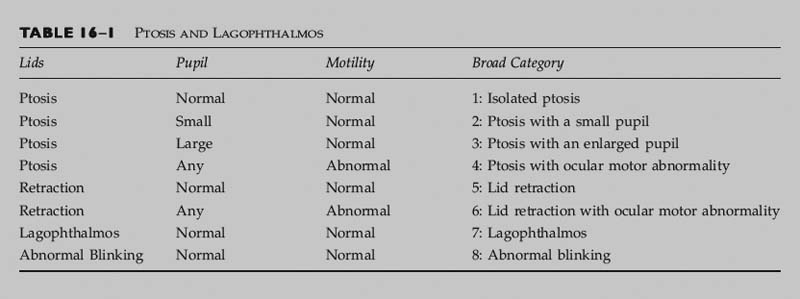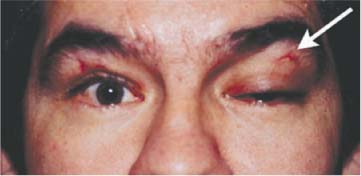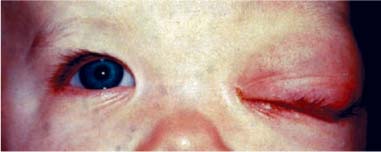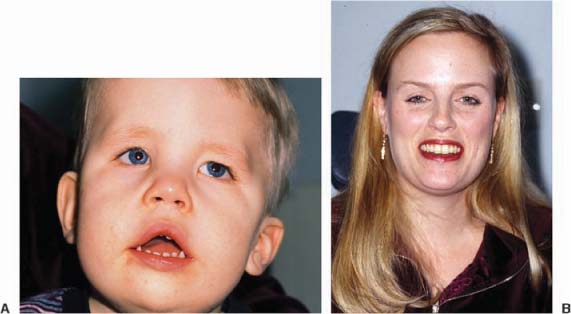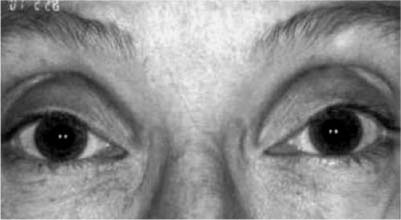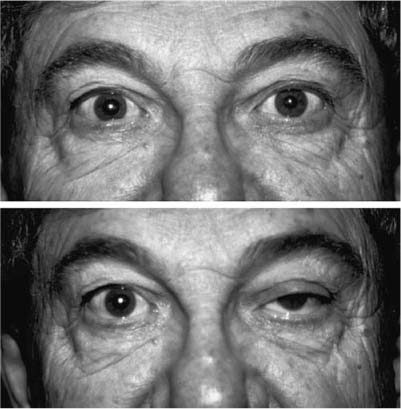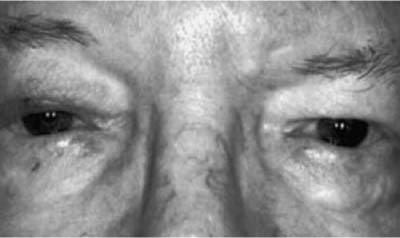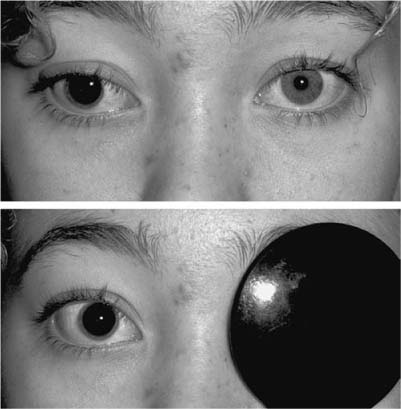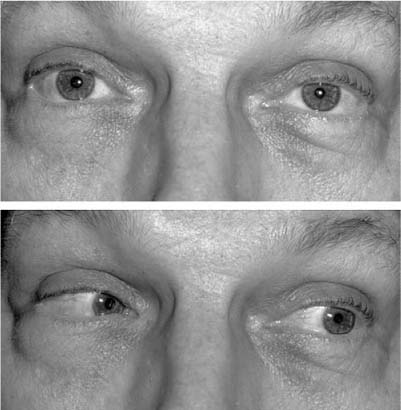Chapter 16 This chapter can be used to help you diagnose a patient who has presented with an abnormality of lid position. The first consideration is to determine if the lid is ptotic (droopy) or retracted, or if there is an inability to close the eye. The second consideration is to look for associated signs with the lid findings that help direct you to the correct diagnosis, so that appropriate workup and therapy can be initiated. Table 16–1 is used for abnormalities of lid position. Before using this table, you should establish the following: Lids: Is the lid ptotic, retracted, lagophthalmic (incompletely closed), or is blinking abnormal? Pupil: Is the pupil on the affected side normal, small, or large? Motility: Is the motility normal or abnormal? 1. Is there a history of contact lens use? Hard contact lens use is a common cause of isolated ptosis in a young patient. 2. Is there a history of trauma? Are there any visible signs of injury on the lid (Fig. 16–1A)? 3. Is there an abnormal shape to the lid, lid crease, or sulcus over the globe? This may suggest an infiltrative tumor or neurofibroma (Fig. 16–2). 4. Are the pupils equal? Is the pupil sluggish? Unequal pupils or a sluggish pupil is indicative of efferent disease to the iris motor-sphincter and not an optic neuropathy. If so, also consult Broad Categories 2 and 3. 5. Does the patient have diplopia? If so, also consult Broad Category 4. 6. Is there a history of generalized weakness or hemiparesis? 7. If the ptosis is congenital, it may improve with jaw opening (Marcus Gunn jaw-winking phenomenon), worsen with jaw opening (inverse Marcus Gunn jaw-winking phenomenon), or be associated with an inability to elevate the ipsilateral eye. 8. Is there a family history of ptosis that might suggest the diagnosis of myotonic dystrophy (Fig. 16–3) or oculopharyngeal dystrophy? • The patient usually is not aware of the exact onset of ptosis. • It may be present bilaterally. • Not associated with pain • Usually seen in an older population, but should not be missed in the hard contact lens wearer • The ptosis is almost never complete. • The upper lid crease is raised or absent. • The superior sulcus above the globe is deepened in cases where the ptosis has been present for at least several months (Fig. 16–4). • Patients rarely complain of fatigue. • Typically there is a history of fatigue, and patients may offer that their ptosis is absent upon awakening from sleep and much worse as the day progresses. This can be brought out at the bedside by having the patient stare upward at the examiner’s finger and noting if ptosis worsens (Fig. 16–5). • May be asymmetric and associated with diplopia or generalized weakness • Weakness of eyelid closure • The pupil is never involved. • Cogan’s lid twitch, not necessarily pathognomonic of myasthenia, may be present. This is an abnormal brief retraction of the lid best seen when the patient looks to primary position after looking in the downward direction. It may also be elicited upon making horizontal saccades. • Ptosis may respond to intravenous edrophonium (Tensilon test). FIGURE 16–1 A 37-year-old man who was struck above his left eye with a sharp instrument. He had a concurrent right hemiparesis. A: A laceration is visible on the upper eyelid. B: Motility is consistent with third nerve palsy including an abduction deficit. C: Magnetic resonance imaging (MRI) of the brainstem reveals lesion through the pons on the left side, confirming that the instrument penetrated his brainstem through his orbit. • Serum acetylcholine receptor antibodies may be present. • Patients with the Lambert-Eaton myasthenic syndrome may develop bilateral lid retraction with sustained upgaze. For further information, see Chapter 34. • An apparent ptosis unrelated to defects in eyelid position, caused by one of the following: • Dermatochalasis significant enough to give the appearance of true ptosis (Fig. 16–6) • Abnormally shaped eye (i.e., enophthalmos, phthisis bulbi) • Lid retraction of the contralateral eye • Chronic Bell’s palsy • Voluntary blepharospasm FIGURE 16–2 A 1-year-old with neurofibroma of lid. (Photo courtesy of Dr. John Ng.) FIGURE 16–3 Myotonic dystrophy. Son has triangular-shaped mouth with bilateral ptosis. Mother has mild ptosis and is attempting to raise her eyelids as high as possible. • Hypotropic eye: As the patient fixates with the other eye, the hypotropic eye is pointed downward with a slightly lower lid; the ptosis disappears when the hypotropic eye fixates (Fig. 16–7). • Ptosis of one or both lids may be present. • May be accompanied by blepharospasm • The process is nonparalytic, and the lid may occasionally raise on its own. • Can be found with progressive supranuclear palsy, Huntington’s disease, Wilson’s disease, and after right hemispheric stroke • Exact mechanism of action is unknown FIGURE 16–4 Ptosis related to dehiscence of the levator aponeurosis. There is no upper lid crease and the superior sulcus is deepened and pronounced. 1. Anisocoria may be physiologic. 2. Ptosis with a smaller pupil should always bring up the possibility of a Horner’s syndrome in the differential diagnosis. FIGURE 16–5 A 74-year-old man with ocular myasthenia. The upper photo shows that lid position is normal after “sleep test.” The lower photo shows that 30 seconds later he demonstrates left ptosis. FIGURE 16–6 Dermatochalasis of upper eyelids. • Mild ptosis without anatomic changes to the lid; the ptosis almost never occludes vision • The lower eyelid is often elevated. • Pupil is smaller and anisocoria is worse in the dark. • Dilation lag may be present, tested by watching the pupils as the ambient light is dimmed: the affected pupil will dilate much more slowly than the normal pupil. • Decreased sweating on the face and scalp on the affected side. This is an uncommon finding that occurs when the lesion is proximal to the takeoff of the sympathetic nerves along the external carotid artery. • Facial or head pain is common with third-order Horner’s syndrome. • A contralateral hemiparesis with or without an ipsilateral facial weakness indicates a brainstem lesion. • The presence of an isolated ipsilateral sixth nerve palsy indicates a cavernous sinus lesion (Fig. 16–8). • A concurrent third nerve palsy may demonstrate a smaller resting pupil than the contralateral eye, as the lack of sympathetic innervation reduces pupil size; the lesion is likely orbital or in the cavernous sinus. FIGURE 16–7 Pseudoptosis due to a hypotropic eye. A 13-year-old girl with a right third nerve schwannoma of the cavernous sinus. The right pupil is tonically dilated. The upper photo demonstrates right pseudoptosis when fixating with the left eye. The lower photo shows that with occlusion of the left eye, she fixates OD and the right lid assumes a normal position. FIGURE 16–8 A 54-year-old man with a left sixth nerve palsy and left Horner’s syndrome. His workup revealed a nasopharyngeal carcinoma.
PTOSIS AND LAGOPHTHALMOS
BROAD CATEGORY 1: ISOLATED PTOSIS
QUESTIONS TO ASK AND POINTS TO KEEP IN MIND
LEVATOR APONEUROTIC PTOSIS
Classic Presentation
OCULAR MYASTHENIA
Classic Presentation
PSEUDOPTOSIS
Classic Presentation
LID APRAXIA
Classic Presentation
BROAD CATEGORY 2: PTOSIS WITH A SMALL PUPIL
QUESTIONS TO ASK AND POINTS TO KEEP IN MIND
HORNER’S SYNDROME
Classic Presentation
Stay updated, free articles. Join our Telegram channel

Full access? Get Clinical Tree


